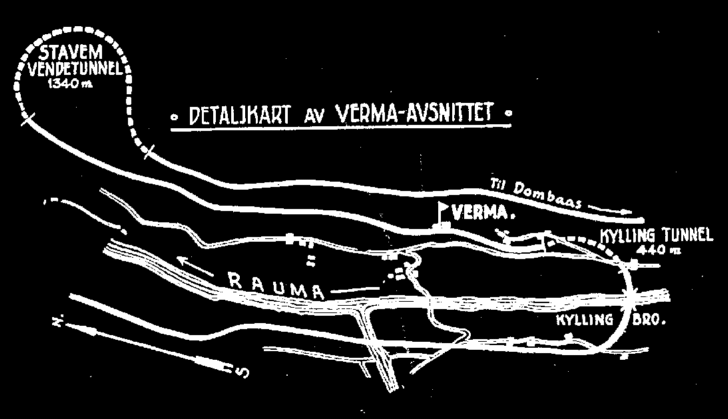
Map of the location.
The Kylling bridge and the tunnel is to the right
The former station in the middle and Stavem Tunnel to the left.
History of Rauma line.
Construction of the line.
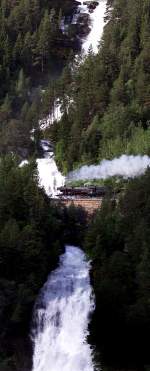 The construction was started in 1912 at Dombås, Kylling Bridge and in
Åndalsnes same year. The limited budget and the invaluation and circumstances
caused by WW I. (1914 - 1918), caused the long construction time than
expected.
The construction was started in 1912 at Dombås, Kylling Bridge and in
Åndalsnes same year. The limited budget and the invaluation and circumstances
caused by WW I. (1914 - 1918), caused the long construction time than
expected.After 12 years of construction and the number of bridges and tunnels (32 bridges and 6 tunnels), Rauma-line was opened in 1924, and the construction had employed 650 men and totaled 14,5 man hours. The cost of the line was 49 million NKr. The large demand of the workers caused that many were employees came from various parts of the country. The workcrew was considered skilled and as hard workers, and they gain respect from the local inhabitants. There are a number of evidence of the skill from the workers, stonebridges were handcrafted in such manner that they still stand as firmly as they were after they were finished. Many of the workers settled down after the construction was over in Romsdalen.
The Raumaline was constructed to serve the Møre and Romsdal counties. But the revenue has been declined after construction of the road, which have since upgraded and after the airport of Vigra at Ålesund with departures to Kristiansand and Molde. The steamengines started to be replaced by diesels in 1958 and 7 years later, the last freighttrain departed Åndalsnes.
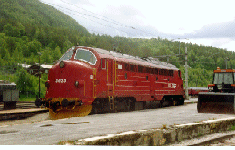
The Di3.s was used in long period of time on the Rauma-line. Here we see one resting before departing with the afternoon train in Dombås
Today the rails have been replaced to heavier rails welded rails of 49 kg per meter on concrete ties. A new top modern freightterminal was constructed to handle the freight, mostly containers now a days, and the tonnage have been increased. The passenger traffic have declined during the years to below 100 000 a year. Today NSB hopes that the number of the passengers will stabilize at 96 000 passengers a year, with the introduction of the two-unit DMU.s that are environmental and lightweight during the year 2000. The New Talents, seats 90, and use only a quarter of fuel compared with Di 3.s used today. With a marketing the very scenic line as a can be turned in to a tourist-line it once was.
Highlights on Verma.
Kylling bridge.
Kylling bro or Kylling bridge is one of the highlights on Rauma-line and is considered as one of the finest and one of most famous structures. This is one of the highlights of Norwegian engineering, combined with the spiraltunnels a it creates a double loop to gain altitude with curves of radius of 275 m on the steep mountainwalls at Verma.The total length of the bridge is 76 meters and is 59,3 meters high over the rapids of the Rauma River. The river is in the area gorged by the high vertical mountainwalls.
The preconstruction of the bridge was begun in September 1913 and the of construction on the bridge footings were begun early January of 1915 and the work on the footings were finished in august same year. To assist the construction, a hanging bridge spanning the gorge was constructed next to the footings to aid the stonelayers. Stone for the main arch was delivered from a quarry and a temporary light rail track was constructed from the quarry to the construction site, a distance of 3.1 km.s the loaded jennies used transport the rocks on this line were using gravity and the empties were pulled uphill by horses.
The rock was cut precisely and the stonelayers used sand to between the joints that could be tapped once the stones was firmly joined, with this construction method the bridge is supported by the pressure of the stones. To able to construct the arch a massive platforms were built with sturdy broads.
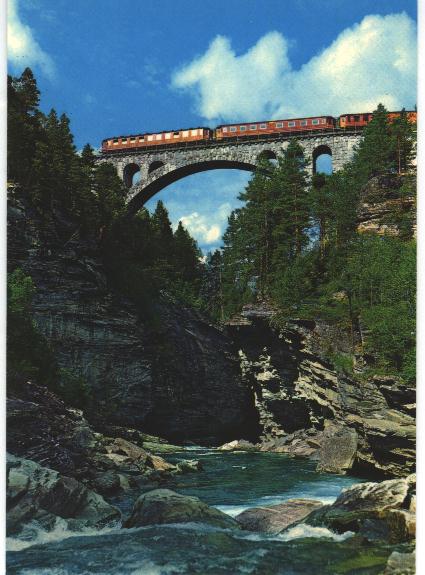
The many workers employed on the construction, were from the local area but the specialized workers were from the southern parts of the country. The construction of the bridge lasted 9 years. and cost 675 000 Nkr. Strange enough, considering the dangerous working site no serious accidents occurred.
During the WW II, the bridge were kept with charges by British and German troops. Happily the structure remains today as a testimony and can be admired by travelers and visitors alike.
Stavem vendetunnel.
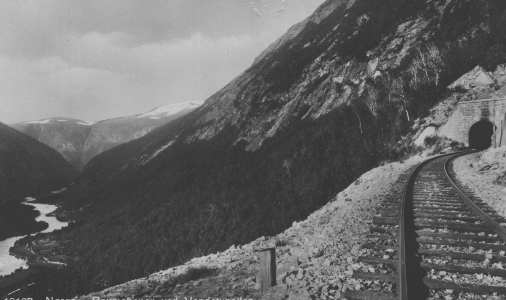
Two of the most interesting tunnels on Rauma-line are the two tunnels in Verma, the Stavem tunnel and the Kylling tunnel, As the track is laid in three different "floors" that extended the route somewhat, but gained 120 meters in altitude by doublelooping the track in the area. The lower portal of the Stavem tunnel is located about 2.3 kilometers northbound from the former station of Verma, closed in 1992.
The work began in this portal and the entire tunnel was drilled by hand. In 1920 the crew had entered 330 meters and from the other portal, where the work began in 1918 380 meters. Because the loose rock in the mountain the work was executed with outmost care.
After extensive inspections the southern part tunnel had to be changed and this could be done without any difficulties. The two crews made the final breakthrough in January 28.th 1922.
Of the total length of the tunnel is 1395 meters, of which 1340 meters are is of mountain rock and the rest inlined. The track is on 1.45 per cent grade towards Dombås, and on that direction the track makes a 291 meter right hand turn of 275 meter radius, followed by strait track of 63 meters and the rest of the track is a right hand curve, also with a radius of 275 meters.
Kylling tunnel.
The tunnel is 440 meters long and is on 1.45 per cent grade. 398 meters of the tunnel is curved track with radius of 275 meters, the rest is straight track. The tunnel was drilled only from one direction, that is from the Kylling tunnel. The work started in 1914, and was a seasonal work during the winters and was finished in 1922. The tunnel has been extended by a snowgallery towards the bridge.The other tunnels on Rauma-line.
- Dombås tunnel
153.90 m - Bolstad tunnel
57 m - Bakke tunnel
59,80 m - Åk tunnel
32,7 m